After the plan for the school was completed work was begun and Baxter Seminary opened its doors in the fall of 1908, with only
the ground floor in the present Girl's Hall, the main education building for the following fifteen years ready for use.
The second story was opened in 1909, and the third and fourth floor were added in 1910.
Soon after the opening of the school in 1908, all that was left in the three defunct schools was brought to Baxter
Seminary. The total amount was not over one thousand dollars.
The Books in the Red Boiling Springs school library were moved to Baxter. They were old, of small print, and
of little use. Some of them are keepsakes. The library books, text books, and the bell from the Summertown Seminary
were also moved to Baxter Seminary. The bell was placed atop of Activity Hall which was later renamed Ivy Hall. There
it remained until after the closing of Baxter Seminary and DeBerry Academy which had acquired Ivy Hall and
Ward Hall.
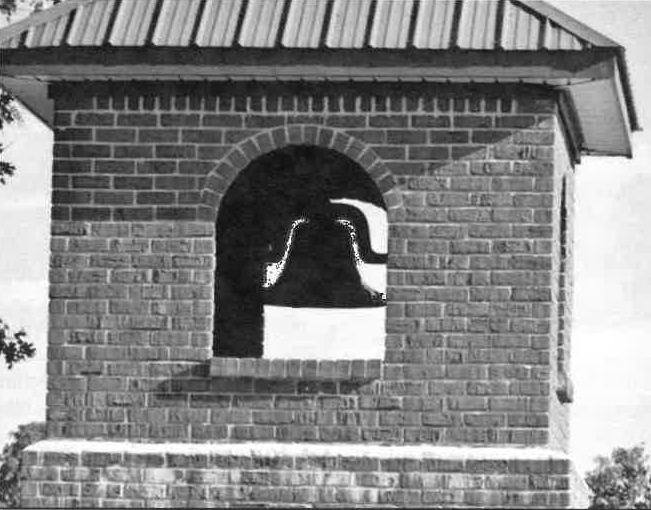 In Return of the Bell by Sandy Curtis, published in The Journal of the Lawrence County (Tennessee) Genealogical
Society, the hunt for the Summertown Seminary Bell is recounted along with the successful efforts of Summertown residents
to reacquire the bell. It was ultimately taken back to Summertown and placed in the Summertown High
School until funds became available to build a small pavilion with a clock tower atop it. Today the bell rests at the top
of the tower at the entrance to Summertown High School where it is admired by students, faculty, and residents of Summertown.
The photo at right shows the bell today as it welcomes students once again.
In Return of the Bell by Sandy Curtis, published in The Journal of the Lawrence County (Tennessee) Genealogical
Society, the hunt for the Summertown Seminary Bell is recounted along with the successful efforts of Summertown residents
to reacquire the bell. It was ultimately taken back to Summertown and placed in the Summertown High
School until funds became available to build a small pavilion with a clock tower atop it. Today the bell rests at the top
of the tower at the entrance to Summertown High School where it is admired by students, faculty, and residents of Summertown.
The photo at right shows the bell today as it welcomes students once again.
Baxter Seminary was granted a charter by the Methodist Episcopal Church on August 18,1910. It filled a huge void
in western Putnam County and adjoining counties for both elementary and secondary
schools. Grades one through twelve were offered and taught. It was not until an elementary school was
built in Baxter, in 1922, that the Seminary focused on and only taught grades nine through twelve.
The cornerstone for Activity hall, later renamed "Ivy Hall", was laid in 1911.
The first graduating class was in 1914. There were eight graduates in that graduating class.
The first Boy's Hall was constructed in 1920. Additions were added as the school population expanded. It was named
Patten Hall in 1931.
By 1922, Baxter Seminary was becoming a vital institution of the Methodist Episcopal Church in this area,
and it was becoming the center of both educational and religious activity. The pastors of the church often served
as directors of religious education at the Seminary. Revival meetings were held in the auditorium of the school.
And during the pastorate of the Rev. S. E. Taylor, 1922-25, the frame building was abandoned as a church. Worship
services were held in the chapel at Baxter Seminary, and lumber from the old building was used in the construction
of a gymnasium at the school. Other assets derived from that property were applied later to the building of a new church." -
History of Methodist Churches and Institutions in Middle Tennessee 1787-1956 by Cullen T. Carter,
Editor
For a period of fifteen years, 1908 to 1923, Baxter Seminary had three presidents; S. E. Ryan served three years, Frank
S. Ditto served five years, and Patton R. Broyles served seven years.
In 1923, Harry L. Upperman arrived in Baxter with his wife Elma with orders to shutter the school. Dr. Upperman saw the
continuing need for a secondary school to serve the area so he and his wife decided to try and continue the school to fill that
need.
When Harry L. Upperman became president on June 23, 1923, the property was valued at $35,012 dollars with an indebtedness of
$5,000 dollars, there were four teachers and fifty seven students. Thirty seven of the students lived within three
miles of the school, plus eight boys and twelve girls lived on the campus.
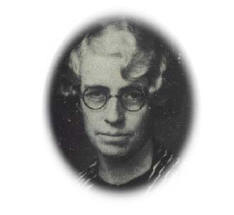 Miss Ethelyn P. Hill joined the Uppermans in 1924, in the survival of the school. Miss Hill left her home in Aibion, MI to
come to Baxter Seminary to teach high school students foreign languages, particularly Latin, Spanish, some Greek, and Hebrew.
She was under the supervision of Dr. Harry Upperman. It was under the sponsorship of the Methodist churches and missionary
work. She was there until Dr. Upperman retired in 1957 when she became associated with Deberry Academy until 1964.
In all she taught school for 62 years. She was the school Dean. Stray leaves from Putnam County, Tennessee by
Mary Hopson pg. 83 Dr. and Mrs. Upperman Faces Challenges and Survived. Photo from the 1942 Highlander Yearbook.
Miss Ethelyn P. Hill joined the Uppermans in 1924, in the survival of the school. Miss Hill left her home in Aibion, MI to
come to Baxter Seminary to teach high school students foreign languages, particularly Latin, Spanish, some Greek, and Hebrew.
She was under the supervision of Dr. Harry Upperman. It was under the sponsorship of the Methodist churches and missionary
work. She was there until Dr. Upperman retired in 1957 when she became associated with Deberry Academy until 1964.
In all she taught school for 62 years. She was the school Dean. Stray leaves from Putnam County, Tennessee by
Mary Hopson pg. 83 Dr. and Mrs. Upperman Faces Challenges and Survived. Photo from the 1942 Highlander Yearbook.
During his first six years as president, the school was cleared of a $5,000 debt, a new presidentís home and guest house was
built which released much needed room in the administration building, and 300 acres of land was added to the campus. Also
during that period, the student body more than doubled. The Presidents's Home and Guest House was erected in 1930.
Construction on Pfeiffer Hall, the new three-story brick administration-academic building including classrooms, was started in
1931 and was dedicated in 1932. Overcrowded conditions caused the school to move into the new building before it was
completely finished. With bricks left from its construction, a new trades school was begun, and completed over the next two
years. Lowe Hall, the new trades building was completed in 1934. Much work on all the buildings was done by students.
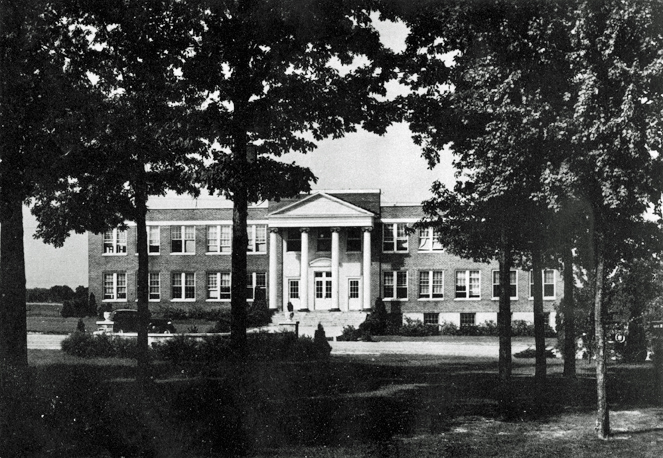 "The purpose of Baxter Seminary, as published in its 15th annual catalogue, 1934-25, began with a statement from
President Harry L. Upperman: 'Instruction is the least part of education.' The aim continued 'While with our
well-trained teachers we offer a superior quality of instruction, our purpose is broader. We endeavor to develop the
student's powers and to make him the master of them. We strive to maintain such influences as will foster the
highest patriotic, moral, and spiritual ideas. While the seminary enjoys a liberal patronage by the citizens of
Baxter, it is in no sense a local school. Its design is to serve the Upper Cumberland section of Tennessee, and other
parts of the country, those choice men and women who desire such advantages as we offer and help them to equip
themselves for leadership.'
"The purpose of Baxter Seminary, as published in its 15th annual catalogue, 1934-25, began with a statement from
President Harry L. Upperman: 'Instruction is the least part of education.' The aim continued 'While with our
well-trained teachers we offer a superior quality of instruction, our purpose is broader. We endeavor to develop the
student's powers and to make him the master of them. We strive to maintain such influences as will foster the
highest patriotic, moral, and spiritual ideas. While the seminary enjoys a liberal patronage by the citizens of
Baxter, it is in no sense a local school. Its design is to serve the Upper Cumberland section of Tennessee, and other
parts of the country, those choice men and women who desire such advantages as we offer and help them to equip
themselves for leadership.'
- Pfeiffer Hall photo: Baxter Seminary Highlander
The publication of the first Baxter Seminary yearbook, The Highlander, took place in 1934.
The first boys dormitory was destroyed by fire at the end of 1936.
For thirty-four years Dr. Harry L. Upperman served as President of Baxter Seminary, a Methodist coeducational secondary school in
the upper Cumberland region of Tennessee. There he worked since 1923 to train young students not only academically, but socially,
vocationally, and spiritually. During this time Baxterís enrollment increased from about 80 students to over four hundred.
The first gymnasium was constructed across the street from Pfeiffer Hall in 1937.
Ward Hall, the new boys dormitory was constructed in 1938.
The new science building, Merner Hall, was completed in 1944. It provided needed class room space and a modern facility for the instruction of the sciences. The Trade School was moved into Merner Hall. The Trade School had formerly been located in the basement of Pfeiffer Hall. Laboratory equipment built by students in the Trade School was moved into Merner Hall.
Near the end of 1954 the first gym was destroyed by fire. Plans for a new gym were started immediately,
The Friends Gym, so named as funds to complete a new gym were raised by friends of Baxter Seminary, was erected in 1955-56.
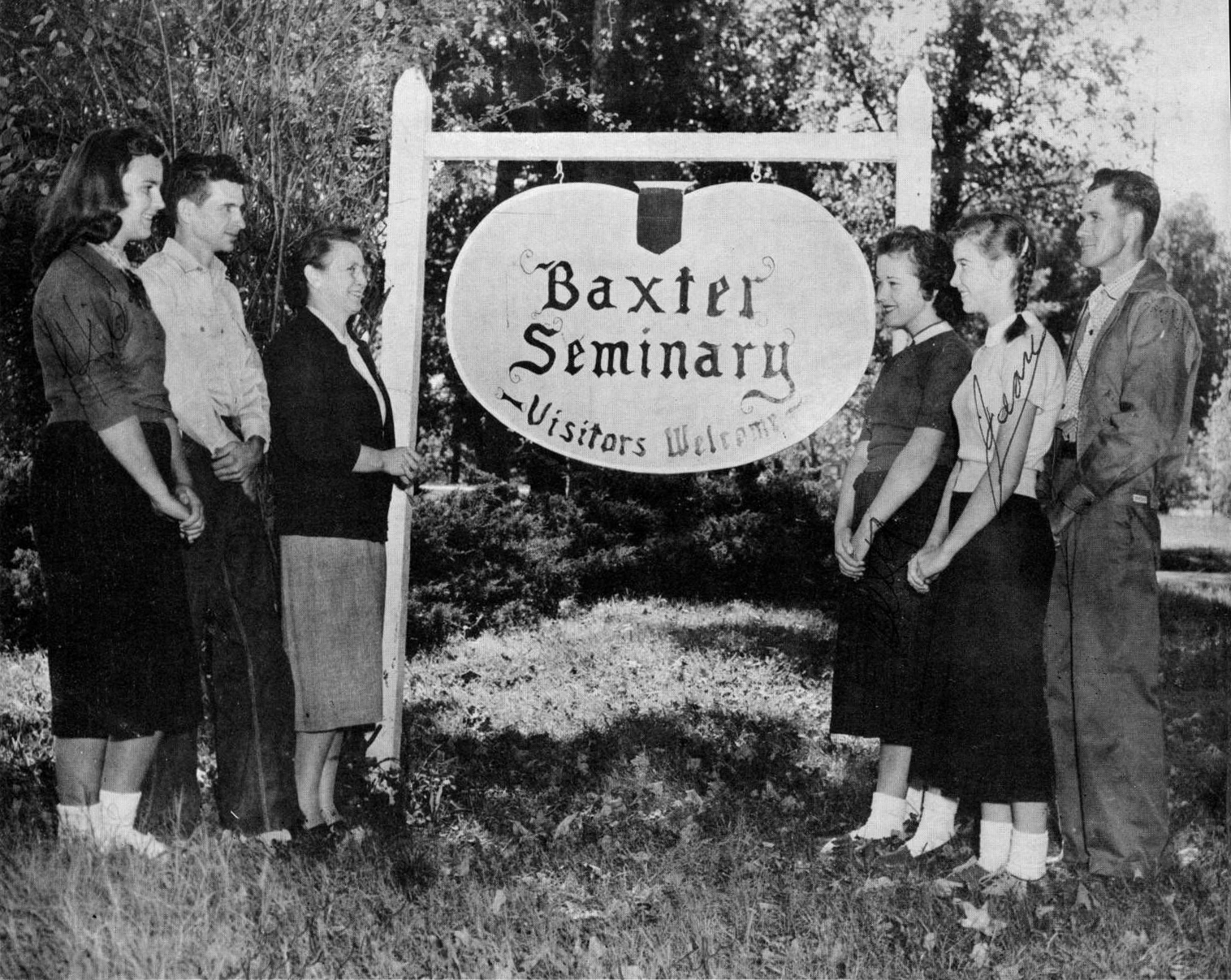 Physical facilities at the school were vastly improved since the beginning of Dr. Uppermanís administration. During his first
six years as president, the school was cleared of a $5,000 debt, a new presidentís home and guest house were built which released
much needed room in the administration building, and 300 acres of land was added to the campus. Also during that period,
the student body more than doubled. "Through the years 1923-57 Baxter Seminary enrolled students from many states and from
other countries, including France, and also from South America." - A Light on the Cumberland Plateau, The
Story of Baxter Seminary by Ruth Robinson Matthews
Physical facilities at the school were vastly improved since the beginning of Dr. Uppermanís administration. During his first
six years as president, the school was cleared of a $5,000 debt, a new presidentís home and guest house were built which released
much needed room in the administration building, and 300 acres of land was added to the campus. Also during that period,
the student body more than doubled. "Through the years 1923-57 Baxter Seminary enrolled students from many states and from
other countries, including France, and also from South America." - A Light on the Cumberland Plateau, The
Story of Baxter Seminary by Ruth Robinson Matthews
Rev. Paul A Barker became the fifth president of Baxter Seminary in 1957. Years before, the Methodist Church had entered an
agreement with the Putnam County Board of Education to provide secondary school education for boys and girls in the western
section. Under the agreement the county paid the salary of 14 of the about 20 teachers, plus $9.70 for each county
student. In the Spring of 1959 the seminary's board of trustees notified the Putnam county board of education that the
agreement for the seminary to accommodate high school students in the western section will be terminated within two years.
Negotiations began immediately and the school campus and facilities were bought by Putnam County for $200,000. At the end
of the 1958-1959 school year Baxter Seminary closed and Upperman High School, on the former seminary campus, opened the 1959-1960
school year with Dave C. Huddleston as its first Principal.
The following brief history is from the Advisory Committee to Baxter Seminary in 1958:
Baxter Seminary is a Service Center in secondary school training,
with eighteen complete academic courses, plus vocational agriculture (school farm), truck farming, home economics, Bible
Department, stenography, bookkeeping, office practice, music, speech, dramatics, masonry, vocational trades department,
general building trades, carpentry, plumbing, mechanical drawings, blue print study, and self-help workshops available to
all worthy students.
Baxter Seminary now covers Administration Building, Health and Physical Education Plant, the Ward Hall for Boys, D.A.R
Health House, Merner Science Hall, farm of 280 acres, three barns, seven homes for faculty members and staff members,
an orchard, Library (volumes 4,116), trade School with two buildings and all required equipment, central heating plant,
summer school site at Center Hill Dam Lake, football field, planned Odell Civic Park in progress on campus land set aside,
with chapel-to-be as next dream.
The President secures financial aid from the Board of Education of the Methodist Church, the Tennessee Conference Board
of Education, various churches, classes, clubs, groups of friends and individuals, gifts of money, material, coal, and
services rendered free, keeping the budget balanced yearly.
At the author's request Dr. Upperman prepared the following description of activities at Baxter Seminary: At this time
there were 387 enrolled, of whom 204 were boys and 183 girls. About twenty veterans were enrolled in regular
secondary school courses, the curricula is that of an A-1 secondary school and is so listed by the Department of Education
of the State of Tennessee. It is a member of the Southern Association of Schools and Colleges and is approved by the
University Senate of the Methodist Church, also Mid-South Association of Independent Schools, and the Central States
Association of Southern Schools.
"Baxter Seminary specializes in a self-help program in which much emphasis is placed on constructive building. Not
only do the students work their way through a considerate degree in these days of high prices, especially if the student is
worthy and in need of such self-help service, but the student has the privilege of making beautiful, as well as useful,
articles, creating buildings, erecting houses, barns, and school structures.
On the campus of Baxter Seminary, through students labor under the self-help program, the following buildings have
largely been erected: The Trades School, the Boy's Hall, with each additional wing having been added as needed; the Health
House, and to a considerable degree, a gymnasium, now planned anew; a great deal of Pfeiffer Administration-Academic
Building and various faculty homes. Also done by student help are four or five houses upon the campus which were
remodeled by the students under faculty supervision.

Much attention is paid to the health of the faculty and students, and for that purpose the Health House is under the
care of a capable director and has in it twenty-two hospital beds, as well as the regular offices for a doctor and a nurse
and two faculty apartments and its own living quarters.
The religious life of Baxter Seminary is constantly kept at a high level, Under student direction, but with faculty
supervision, the students conduct many of the regular daily chapel services, hold prayer meetings in the dormitories,
carry on Young Women's Christian Association and the Young Men's Christian Association in both day and evening groups,
and the Methodist Youth Fellowship which has as its president a junior girl, also the chairman of evangelism for the
district.
Daily Bible reading is under the direction of the director of Bible and Religious Education Classes, and the presence upon
the faculty of returned missionaries who served in Africa and India has aroused a great deal of interest in missionary
work. Often students have regular charges and a number plan to study for the ministry, while fifteen graduates
within recent years have entered the ministry. Some girls are preparing for the missionary service and other girls
are seeking to be nurses and to engage in other forms of Christian service.
On the faculty at the present time are several graduates of Baxter Seminary, and the two Trades Schools are directed by
graduates of Baxter Seminary in those fields. In Putnam and surrounding counties are many teachers who are graduates
of Baxter Seminary, while other graduates are in the business world, farming, office work, and are general, useful citizens
of their communities, and in various church activities.
The girls who have taken Home Economics and kindred subjects have contributed to finer homes and home life in this
section of the state.
During the recent World War over 400 graduates and former students and faculty members (both men and women) served the
nation in all branches of the service.
The graduates of Baxter Seminary are not only found in all walks of life throughout the Upper Cumberland section but
are now spreading across the nation and are found in many industrial centers, thus showing the school has grown away from
serving only nearby communities but is serving those needs and also other sections and helping to prepare not only
students with academic knowledge but also those who are of service as ministers, doctors, lawyers, bookkeepers, accountants
mechanics, draftsmen, carpenters, brick-layers, blacksmiths, teachers of various farm and trade subjects, vocational
directors, and general office workers.
The school is without debt and is striving hard to remain that way. It is in need of 150 workships at $200.00 to
$300.00 each which enable a school to help a boy or girl on the self-help program as the workship provides the working
capitol with which the school may operate while the student is getting the benefit of student aid through work.
Members of the faculty and of the student body give time in speaking, singing, preaching, teaching, conducting services
to churches over the Conference.
Special gospel teams are often taken on a number of special missions.
This brief history had been prepared under the guidance of the Advisory Committee composed of C. S. Jenkins, chairman:
W. T. Sewell, Lawrence Grace, Walter Keith Crawford, Luther C. Harris, of the board of trustees of Baxter Seminary, who
prepared the data from facts obtained from other trustees, faculty students and friends, in Baxter and elsewhere, and find
that President Harry L. Upperman, with his wife, has kept the entire institution on an even financial keel and secured
endowment, buildings, equipment, land, which could not be today duplicated by a million dollars.
The services rendered to people cannot be valued.
This committee believes that as worthy a cause merits aid from every source, in order that $15,000.00 to $20,000.00 per
year may bring a balanced budget."
(November 15, 1958 - The Leaf Chronicle, Clarksville, TN)
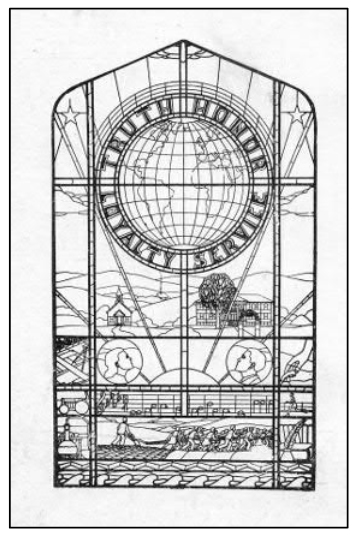 "The simulated stained glass window which
hangs in the office of the President was designed and drawn by
Baxter Seminary students under faculty supervision. In it is seen clearly the founding, growth, and ideals of
Baxter Seminary. The lower part of the window depicts the breaking of the ground by seventy-five school children
drawing the plow. This scene was repeated on the campus when Pfeiffer Hall was built. Above it and on both
sides are shown various phases of the school programs such as science, agriculture, mathematics, mechanical arts,
literature, athletics, vocational guidance, and music exemplified by the school Alma Mater. As has always been
the case the boy and girl look to the church and the school for guidance and inspiration. The world to serve, the
school motto Truth, Honor, Loyalty, and Service, and through it all the symbol of the cross, portray the ideals of
Baxter Seminary. May her students ever be worthy and carry high such ideals." The
Simulated Stained Glass Window Story and photo were featured in the Baxter Seminary, Highlander, 1943.
"The simulated stained glass window which
hangs in the office of the President was designed and drawn by
Baxter Seminary students under faculty supervision. In it is seen clearly the founding, growth, and ideals of
Baxter Seminary. The lower part of the window depicts the breaking of the ground by seventy-five school children
drawing the plow. This scene was repeated on the campus when Pfeiffer Hall was built. Above it and on both
sides are shown various phases of the school programs such as science, agriculture, mathematics, mechanical arts,
literature, athletics, vocational guidance, and music exemplified by the school Alma Mater. As has always been
the case the boy and girl look to the church and the school for guidance and inspiration. The world to serve, the
school motto Truth, Honor, Loyalty, and Service, and through it all the symbol of the cross, portray the ideals of
Baxter Seminary. May her students ever be worthy and carry high such ideals." The
Simulated Stained Glass Window Story and photo were featured in the Baxter Seminary, Highlander, 1943.
Dr. John T. Morgan, artist, was the guest instructor at Baxter Seminary for two weeks in January 1940. Dr. Morgan came
to the school under the auspices of the Conference of Southern Mountain Worker, with offices at Berea College, Berea, KY.
Dr. Morgan taught volunteer students several types of sketching, painting and basic work. He also helped with the design
and set up of the stained glass window.
Dr. Morgan had many years experience in the building of stained glass windows, having worked with the master of the craft,
Dr. Swanney of Chicago. Three of Dr. Morganís windows were displayed at the Chicago World Fair and another is in place
at the Methodist Headquarters Building in Chicago.
History extracts and quotes from:
All Roads Lead to Baxter: A Story of Baxter Seminary, Baxter, Tennessee by Anita Cunningham Mitchum
www.ajlambert.com
Advisory Committee to Baxter Seminary - (November 15, 1958 - The Leaf Chronicle, Clarksville, TN)
History of Methodist Churches and Institutions in Middle Tennessee 1787-1956 by Cullen T. Carter,
Editor
The Putnam County Herald
Baxter Seminary photos: Baxter Seminary Yearbooks 1934-1960 By Mike and Audrey Lambert
www.ajlambert.com
Baxter Seminary Sign: UMC photo

